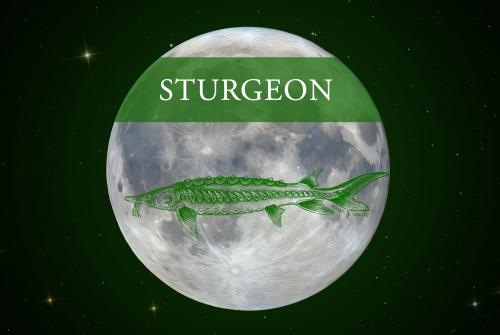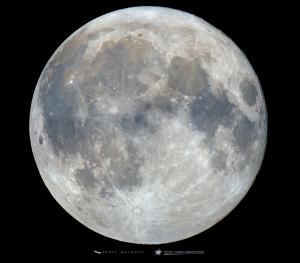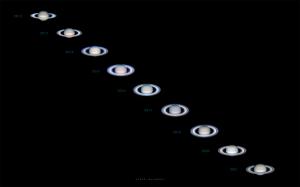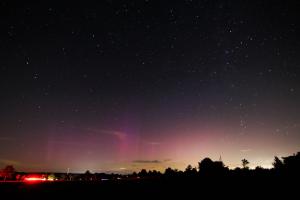Celebration of Space - August 16, 2024
This coming Monday, August 19, 2024 at 2:29 pm ET, the Moon will orbit into alignment with the Earth and the Sun on the opposite side of Earth than the Sun. This will place the side of the Moon that we see in direct sunlight. This is the full Moon, and places the Moon in the sky for the entire nighttime period.
Like all full lunar phases, the August Moon has a common name that relates to historical occurrences of events in August. According to the Old Farmer’s Almanac, the August Moon carries the moniker – the Full Sturgeon Moon. This name comes from the large fish that were caught this time of the year in the Great Lakes and Lake Champlain. Other names that the August Moon go by are: the Green Corn Moon, the Black Cherries Moon, and the Mountain Shadows Moon.
Though some sources have been referring to the August Moon as a Supermoon, which is when the full lunar phase coincides with the lunar perigee. The lunar perigee is the Moon’s closest point to Earth in its 27.3 day orbital period. Since the full phase occurs on August 19th at 2:29 pm and the lunar perigee occurs on August 21st at 1:06 am, we do not consider the August Moon of 2024 a Supermoon. With that said, the September full Moon will be a Supermoon.
Monday’s full Moon is also a Blue Moon, but not to the modern definition that states the second full Moon in the same month is a Blue Moon. Instead, Monday’s Moon will stick to the original definition of a Blue Moon, which is the third full lunar phase in a season with four full moons. The first full Moon of summer was the Strawberry Moon on June 21st (ET), the second was the Buck Moon on July 21st, Monday’s Sturgeon Moon is the third, and the fourth is the Corn Moon / Harvest Moon – which occurs on September 17th (ET). Will the Moon actually look blue on Monday? Well, no, the Moon will probably look reddish-yellow due to all the wildfire smoke we see during Southern New England August. The name has nothing to do with the actual color of the Moon, and all the images you have seen of “blue” moons have had blue enhancements added. In any case, get out and see the Full Blue Sturgeon Moon of August 2024, and note how un-blue it is.
Now that we are closing on the opposition of Saturn, which is when Saturn ends up on the opposite side of Earth than the Sun, the views for 2024 are starting to kick in. Unlike the past several years, observers viewing Saturn in the telescope this year may be a bit surprised by the view, as Saturn’s rings are not as visible as they have been. This is due to the orientation of Saturn’s tilt in regards to Earth’s viewing angle.
Saturn is tilted 26.7º on its axis, and the rings reside over Saturn’s equator. This will make the tilt of Saturn visible in the rings. Saturn will complete one for orbit around the Sun every 29.4 Earth years. Every year, Earth will approach and pass Saturn during our orbit, but as Saturn progresses in its orbit, our view of Saturn’s tilt will change allowing for a view of Saturn’s rings at maximum tilt towards Earth during Saturn’s Summer Solstice, then 14.7 years later our view sill show the underside of Saturn’s rings when they are at maximum tilt away from us during Saturn’s Winter Solstice. During Saturn’s Equinoxes the rings will not be tilted towards or away from Earth, making them difficult to see. The Autumnal Equinox on Saturn occurs in 2025, which places the orientation of Saturn’s rings, from our viewpoint in 2024, at nearly on edge. The result is a significantly less detailed view of the rings. Even though a view of the rings will be difficult in 2024, during 2025 the rings will appear almost non-existent.
Saturn’s opposition will occur on September 8, 2024, which places Saturn into best viewing for the year. Be sure to visit Frosty Drew or another observatory in September to catch a view of Saturn and take note of how little of the rings are visible compared to 2017 when Saturn experienced its Summer Solstice.
This past Monday morning, August 12, 2024, we had another surprise showing of the Aurora Borealis over Rhode Island, and Southern New England. Considering that the Sun is at the maximum side of activity for its eleven year cycle, it is not all that strange to see this increased level of solar related phenomena. Frosty Drew Astronomers were on site for the annual Perseid Meteor Shower peak on Monday morning and noticed the view of the Northern Lights. Even though it is difficult to predict how intense a view of the Aurora may be, one thing is for sure, the Sun is quite active during the current solar cycle (Cycle 25), and we will likely have more opportunities for low latitude Aurora over the next year or so. Now keep your eyes to the sky because you never know what you may see.
- Author:
- Scott MacNeill
- Entry Date:
- Aug 16, 2024
- Published Under:
- Scott MacNeill's Columns





